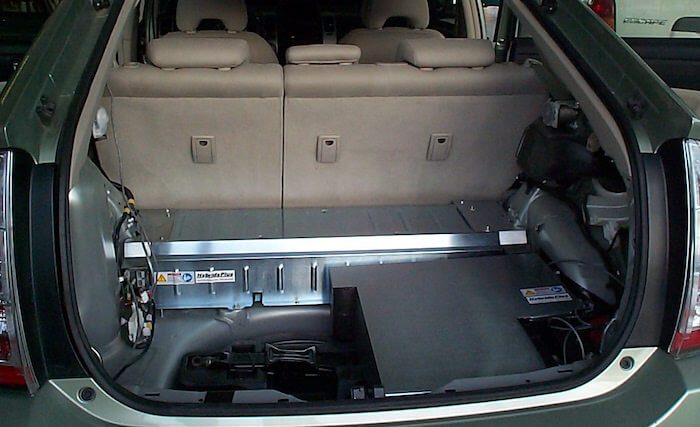
P0A7F Hybrid Battery Worn
Content
P0A7F Hybrid Battery Worn
OBD-II DTC Datasheet
Hybrid battery pack worn out
What does this mean?
This is a generic Diagnostic Trouble Code (DTC) applicable to many OBD-II vehicles (1996 and newer). This may include, but is not limited to, vehicles from Honda (Accord, Civic, Insight), Toyota (Prius, Camry), Lexus, etc. Despite the general nature, the exact repair steps may vary depending on the model year, brand, transmission models and configurations.
A stored P0A7F code in your hybrid vehicle (HV) means the powertrain control module (PCM) has detected excessive resistance or insufficient charge from the vehicle's high voltage battery. This code should only be stored in hybrid vehicles.
An HV (Nickel Metal Hydride) battery typically has eight (1.2 V) cells in series. Twenty-eight of these cells make up the HV battery pack.
The hybrid vehicle battery management system (HVBMS) is responsible for regulating and monitoring the high voltage battery. HVBMS interacts with PCM and other controllers as needed. The PCM receives data from the HVBMS via the Controller Area Network (CAN). Individual battery cell resistance, temperature, battery charge level and overall battery health are among the functions that are constantly monitored by the HVBMS.
High Voltage Hybrid Battery Packs consist of twenty eight battery cells that are connected together using busbar connectors and high voltage cable sections. Usually each of the cells is equipped with an ammeter / temperature sensor. HVBMS monitors data from each cell and compares individual resistance and temperature levels to determine the exact rate of battery wear.
If the HVBMS gives the PCM an input that indicates a mismatch in battery or cell temperature and / or voltage (resistance), a P0A7F code will be stored and the malfunction indicator light may illuminate. Many vehicles will require multiple ignition fail cycles before the MIL illuminates.
Typical Hybrid Battery: 
What is the severity of this DTC?
Deterioration of the battery and a stored P0A7F code may result in the shutdown of the electrical power unit. The P0A7F should be classified as severe and the conditions that contributed to its storage should be addressed urgently.
What are some of the symptoms of the code?
Symptoms of a P0A7F DTC may include:
- Decreased vehicle performance
- Reduced fuel efficiency
- Other codes related to high voltage battery
- Disconnection of the electric motor installation
What are some of the common causes for the code?
Reasons for this code may include:
- Defective high voltage battery, cell or battery pack
- Loose, broken or corroded busbar connectors or cables
- Defective generator, turbine or generator
- HVBMS sensor malfunction
- HV Battery Fans Not Working Properly
What are some steps to troubleshoot the P0A7F?
Diagnose and repair any battery charging system codes that are present before attempting to diagnose P0A7F.
To correctly diagnose the P0A7F code, you will need a diagnostic scanner, a digital volt / ohmmeter (DVOM), and a HV battery system diagnostic source.
I would begin my diagnosis by visually inspecting the HV battery and all circuitry. I was looking for corrosion, damage or open circuit. Remove corrosion and repair (or replace) defective components as necessary. Before testing the battery, make sure the battery pack is free of corrosion problems and that all connections are secure.
Then I connected the scanner to the vehicle diagnostic socket and got all the stored codes and the corresponding freeze frame data. I would write this information down, clear the codes and test drive the vehicle until the PCM enters ready mode or the code is cleared.
If the PCM enters ready mode (no codes are stored), the code is intermittent and can be much more difficult to diagnose.
If P0A7F is reset, use the scanner to monitor HV battery charge data, battery temperature data, and battery charge status data. If inconsistencies are found, refer to these areas using the DVOM and related diagnostic information.
Battery test procedures and specifications can be found in the High Voltage Information Source. Component locations, wiring diagrams, connector faces, and connector pinouts will be vital to making a correct diagnosis.
If the battery is within functional specifications, my next step is to use the DVOM to test the HVBMS sensors (temperature and voltage - according to the manufacturer's specifications and testing procedures). Sensors that do not meet the manufacturer's specifications should be considered defective.
I would also use the DVOM to test the resistance of individual battery cells. Cells that show excessive resistance will require checking the busbar and cable connectors.
Remember that repairing a HV battery is possible but often unreliable. Replacing a HV battery (with an OEM component) is the most reliable method of troubleshooting a battery failure, but can be costly. You can select a used HV battery pack if price is an issue.
- A stored P0A7F code does not automatically deactivate the HV battery charging system, but conditions that caused the code to be stored may disable it.
- If the HV in question has more than 100,000 miles on the odometer, suspect a defective HV battery.
- If the vehicle has traveled less than 100 miles, a loose or rusty connection is likely the cause of the problem.
Related DTC discussions
- There are currently no related topics in our forums. Post a new topic on the forum now.
Need more help with the P0A7F code?
If you still need help with the P0A7F error code, post a question in the comments below this article.
NOTE. This information is provided for informational purposes only. It is not intended to be used as a repair recommendation and we are not responsible for any action you take on any vehicle. All information on this site is protected by copyright.

One comment
David
Hello;
I own a 300 Lexus NX2016h. I get the error P0A7F. But the car continues to function properly, both in terms of power and consumption and the charging and discharging of the hybrid battery. If I erase the check engineer token it reappears after 2000 km. But without noticing anything in the operation of the car. Has anyone had this kind of problem on a Lexus.
Thank you